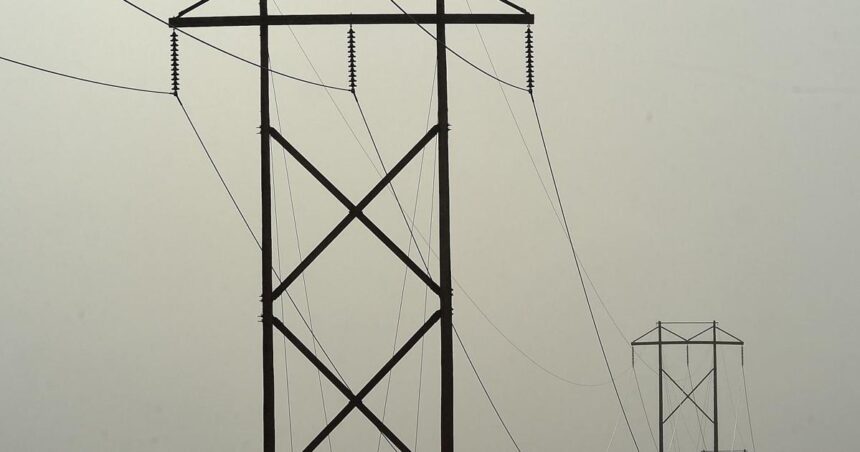The winds endlessly flattening the prairie grass around the southcentral Montana town of Rapelje have become a boon for the local government and public schools.
The latest is a $6 million-plus bonus paid to Stillwater Country, which this year has meant $84,000 each for schools in Rapelje and Reed Point. The money comes from Puget Sound Energy, a utility more than 754 miles away in Bellevue, Washington.
Demand for Montana renewable energy has led to more than a gigawatt of nameplate wind generation built in the state since 2021 and brought the export energy economy to seven Montana counties. But the demand wouldn’t be there without transmission, of which analysts say Montana doesn’t have enough.
Where there’s wire, there is tax revenue for counties. Three southeast Montana counties will split $217 million from NextEra’s Clearwater Wind project over the next 30 years. Also, royalty payments to landowners — up to $30,000 a year for each wind turbine site under 25-year lease.
People are also reading…
“For Stillwater County, the benefit is new industry, an expanding industry, and obviously the northern part of Stillwater County has the right combination of reliable wind, good wind speed, and transmission,” said Tyrell Hamilton, a Stillwater County Commissioner who has seen steady interest in wind farm development over the years.
Legislators taking closer look at fires caused by powerlines
Wind in Montana is a given. The state ranks fifth in the nation for wind energy potential, as scored by the National Renewable Energy Laboratory. For actual wind generation, the state is middle of the pack. Montana ranks 50th on the Grid Modernization Index, with no state grid modernization plan and no mention in Montana’s energy plan of modernizing the grid for resilience.
The Grid Modernization Index is produced by GridWise Alliance, a nonprofit which describes itself as a diverse membership of electricity industry stakeholders focused on accelerating innovation that delivers a more secure, dependable, resilient, and affordable grid to support decarbonization of the U.S. economy.
That Montana has no transmission plan concerns Kyle Unruh. The former NorthWestern Energy employee and current Montana and Idaho policy manager for Renewable Northwest said Montana risks fading out the region’s energy economy without new transmission. There are few ways to the move electricity in and out of state, just four major transmission paths in and out of Montana. The capacity on each is spoken for, which makes exporting electricity a bit of a slide puzzle.
Some in Houston facing no power for weeks after storms cause widespread damage, killing at least 4
“My understanding of Montana’s transmission system is that we are essentially fully subscribed for long-term firm, transmission rights,” Unruh said. “At this point in time, if new generation wants to come onto the system, or anybody wants to seek new transmission rights on a long-term, firm, basis, they are out of luck until some opening is created.”
Renewable Northwest a renewable energy advocacy organization.
Unruh points to the assessments by three different industrial buyers of wholesale energy, each indicating that Montana electricity has become too expensive, the number of purchase options too few. One, REC Silicon, is cutting back on manufacturing in Butte, explaining in February that “we did everything in our power to return profitability to the polysilicon business in Butte, however, forecasts for sustained high electricity costs that are outside of our control necessitated this decision.”
Montana Resources, the state’s largest hard rock mining company, in late February told Unruh, “We are looking at doubling our energy costs with a very limited number of possible suppliers once our contracts are up.”
Giardia cases put Havre under a water boil advisory
Sibanye Stillwater, which mines palladium and platinum not far from Puget Sound Energy’s new wind farm, told Renewable Northwest at the end of April, “We would like to receive a larger response to our choice electric supply (requests for proposal) and are especially interested in receiving those responses from renewable sources. We believe additional transmission resources would improve the number of potential suppliers, as well as improve our potential for acquiring a renewable power supply.”
The opening in transmission that’s made the latest surge in large, wind farm development is the winding down of Colstrip Power Plant. In 2019, when Puget Sound Energy and Talen Energy announced the closure of Colstrip Units 1 and 2, which the two companies co-owned, that freed up the transmission necessary for Clear Water Wind, a 776-megawatt wind project occupying space in three Montana counties adjacent to Colstrip.
Energy dept. identifies southwest North Dakota as potential transmission priority area
Clearwater’s power now flows to Washington’s Puget Sound, and Portland Oregon by way the Colstrip Transmission line. Other projects wait in the wings for further Colstrip closure. Talen and corporate sibling Pattern Energy have plans for the 600-megawatt Silverthorn wind project located in Rosebud and Treasure counties.
Fact sheets on the project suggest it will cost $1 billion to build and will pay $150 million in property taxes over its 30-year life. Lease terms offered to landowners suggest an 8% royalty and annual compensation of $25,000 to $30,000 a year per wind turbine for 30 years.
Talen Energy’s Wind Agreement Compensation Fact Sheet
The politics of wind in coal county are fraught. The town of Colstrip initially suggested its namesake power plants substation could only be reached by Clearwater if the wind farm buried the final run of its high voltage line. It was a burdensome measure the region’s pro-coal state legislators lobbied community leaders against, knowing the wind farm developed by NextEra would benefit the rest of Rosebud County.
Colstrip’s substation serves as Clearwater’s onramp to the Pacific Northwest.
Conversely, promotional material for Silverthorn Wind identifies Talen as the owner and operator of approximately 12.4 gigawatts of high-quality power infrastructure in the United States, including Montana. There’s no mention of Talen’s 15% ownership stake in Colstrip.
Talen Renewables Northwest, a partnership between Talen Energy and Pattern Energy is doing the ground work for a wind farm near Colstrip. A landman has been hired and lease terms are being offered.
Talen didn’t respond to calls and emails concerning its plans for both Silverthorn and Colstrip Power Plant. Earlier in May, the Texas-based independent power producer told shareholders its plans to acquire Puget Sound Energy’s 370-megawatt capacity share of Colstrip Units 3 and 4 had been cancelled. Talen doesn’t have transmission capacity on Colstrip Transmission Line, leaving it in the same slide-puzzle predicament described by Unruh when it comes time to export Silverthorn electricity.
Three of Colstrip’s six utility owners are investing in Montana wind power as they reach exit dates for Colstrip. Puget Sound Energy buys electricity from NextEra and is building the 248-megawatt Beaver Creek wind farm in the hills near Rapelje.
Portland General Electric has an ownership stake in the Clearwater and says it is looking for other Montana opportunities.
Trump’s new trade war would cost middle-class families at least $1,700 a year, report warns
PacifiCorp, which owns a 20% share of Colstrip, constructed the 250-megawatt Pryor Mountain Wind Project near Bridger. Pryor Mountain Wind energy flows into Wyoming on PacifiCorp’s Yellowtail Intertie, a connector for Yellowtail Dam.
PacifiCorp has a unique hand to play in Montana’s transmission future. The six-state utility that has a combined 1.8 million customers, including those of its Rocky Mountain Power business unit. Berkshire Hathaway owns it. Berkshire, through its subsidiaries, is the only energy company with an ownership stake in every major transmission path connecting Montana to the rest of the West.
Berkshire Hathaway Energy in 2022, purchased three Montana wind farms in the Cut Bank region with a nameplate capacity of 399 megaw





